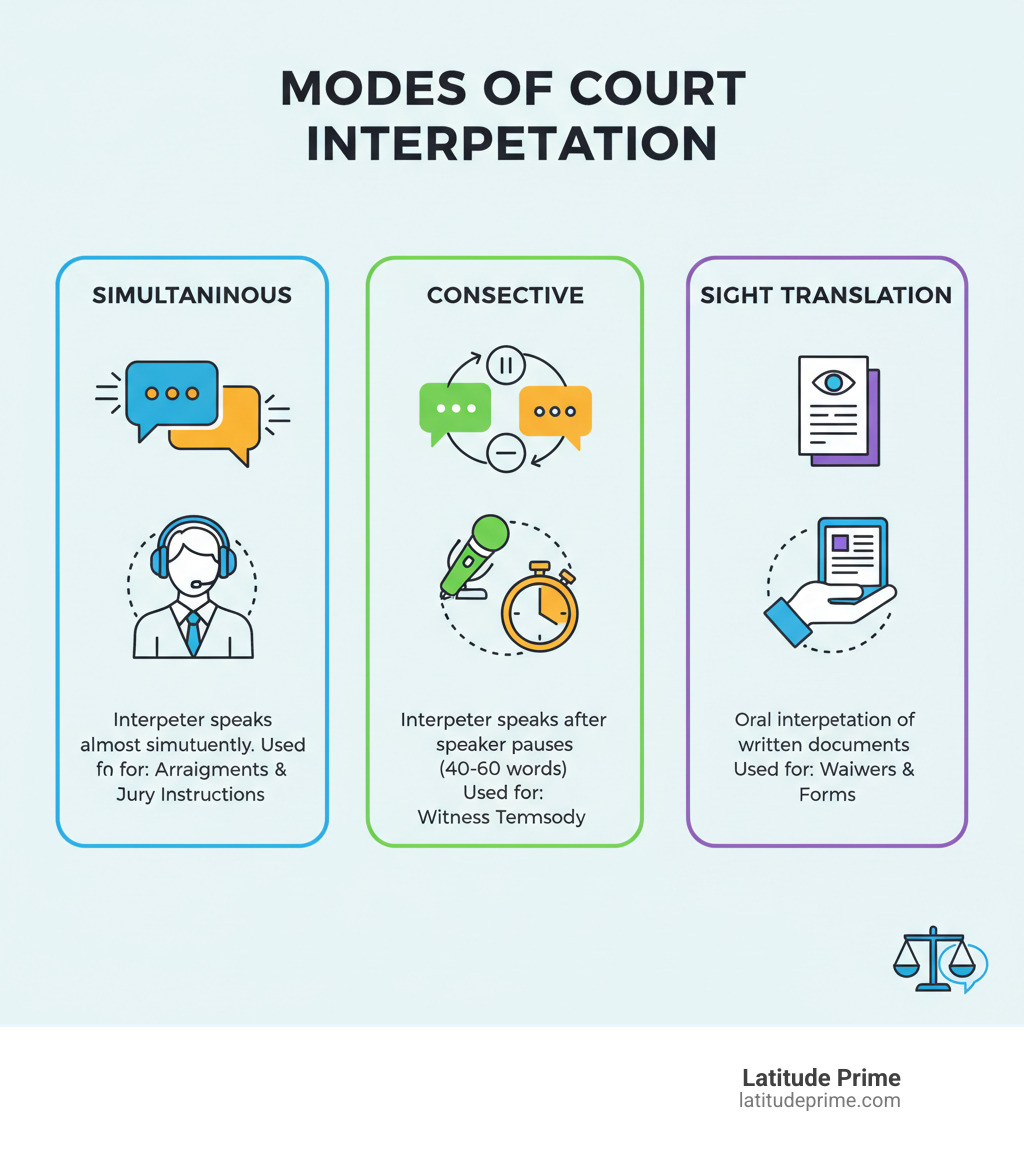Legal Court Interpreter: 3 Essential Modes Guide
Why Legal Court Interpreters Are Essential to Justice
A legal court interpreter is a trained professional who facilitates communication between parties speaking different languages in legal settings. They ensure fair access to justice by using specialized interpretation modes and adhering to strict ethical codes in courtrooms, depositions, and more.
Quick Answer for Those Seeking to Become a Legal Court Interpreter:
- Meet basic requirements – Be at least 18 years old with high proficiency in English and your target language
- Pass required exams – Written exam (80% passing score), Oral Proficiency Exam, and Bilingual Interpreting Exam (70% per section)
- Get certified or registered – Complete certification for common languages (Spanish, Mandarin, etc.) or registration for less common languages
- Expect to earn – $60-70/hour as a freelance interpreter, plus travel compensation
- Maintain ethics – Follow strict codes of conduct including accuracy, impartiality, and confidentiality
In British Columbia, interpreters are needed for about 7,500 court appearances annually. In the U.S., the Court Interpreters Act mandates qualified interpreters in federal courts for non-English speakers or the deaf. This is not just a convenience—it’s a fundamental right, grounded in natural justice and enshrined in laws like Section 14 of the Canadian Charter of Rights and Freedoms.
The stakes are high in criminal and civil cases. Language barriers cannot impede justice. Court interpreters bridge these gaps with precision, acting as invisible conduits to maintain the integrity of every word.
This guide covers the legal foundations of court interpreting, the path to certification, daily professional life, and what it takes to succeed in this demanding but rewarding field.

The Crucial Role and Legal Foundation of Court Interpreting

The legal system relies on clear communication. To ensure justice is accessible and fair, everyone must understand and be understood. The legal court interpreter makes this possible, fulfilling a role so vital it’s considered a fundamental right.
A legal court interpreter ensures language is never a barrier to due process. Without them, those with limited English proficiency would face an unfair disadvantage. These professionals guarantee fair trials and uphold access to justice, acting as guardians of equal treatment under the law.
The Differences Between Interpreters and Translators
While often used interchangeably, “interpreter” and “translator” are distinct professions.
Interpreters work with spoken language in real-time, conveying speech from one language to another. This role demands active listening, quick processing, a strong memory, and accuracy under pressure. Cultural competence and ethical awareness are also critical in high-stakes environments like courtrooms.
Translators work with written text, converting documents from a source language to a target language. This requires excellent writing skills, subject matter expertise, attention to detail, and proficiency with translation software.
The output is also different: interpreters provide oral communication in the moment, while translators produce written documents like contracts or court filings that can be reviewed later.
Both professions require bilingual fluency, but the way that fluency is applied differs fundamentally. A court interpreter must think on their feet and convey meaning instantly, while a translator has the luxury of time to ensure precision and polish in their written work.
The Right to an Interpreter in Canada and the US
The right to an interpreter is a fundamental right grounded in the principles of natural justice and enshrined in law in both Canada and the US.
In Canada, Section 14 of the Canadian Charter of Rights and Freedoms guarantees this right for any party or witness who does not understand the language of the proceedings or is deaf. This right is linked to other Charter sections ensuring fundamental justice (s. 7), a fair trial (s. 11(d)), and equality (s. 15), reflecting Canada’s commitment to diversity.
The Supreme Court of Canada has affirmed that interpretation must be continuous, precise, impartial, competent, and contemporaneous, reflecting the critical nature of the work.
In the United States, the Court Interpreters Act (28 U.S.C. § 1827) governs the use of interpreters in federal courts. It ensures that individuals with limited English proficiency (LEP) or hearing impairments can participate fully in legal proceedings by requiring a program for certified and qualified interpreters.
State courts have also established comprehensive programs to ensure language access. California, for example, maintains one of the most robust court interpreter programs in the country. These initiatives underscore the nationwide commitment to linguistic fairness.
At Latitude Prime, we’re committed to meeting these legal mandates through our comprehensive Official Government Translation & Interpretation Services. We understand it’s about having the right interpreter with the appropriate certifications and expertise to serve the court effectively.
The Three Modes of Court Interpretation
Court interpreters use three primary modes, adapting their approach to the demands of each legal setting.
Simultaneous interpretation is when the interpreter speaks at nearly the same time as the original speaker. This mode requires intense concentration and the ability to listen and speak concurrently. It is used for arraignments, jury instructions, and lengthy testimony to ensure a continuous flow of information. This requires a vast vocabulary and rapid processing skills.
In consecutive interpretation, the speaker pauses every 40-60 words, allowing the interpreter to render that segment into the target language. This mode relies on strong short-term memory and note-taking skills. It is often used for witness testimony, client-attorney interviews, and sentencing, where capturing tone and nuance is critical.
Sight translation is the oral interpretation of a written document on the spot. It demands quick processing and strong reading comprehension to fluently render complex legal concepts. Interpreters use this mode for documents like waivers, police reports, or written evidence that require immediate understanding. The challenge is to accurately convey legal jargon from potentially difficult-to-read documents.
Each mode has unique challenges, and a legal court interpreter often uses all three in a single appearance, switching seamlessly as needed. This versatility makes court interpretation a highly specialized and demanding profession.
To learn more about the broader scope of interpretation services available for various settings and needs, visit our Interpretation Services page.
The Path to Becoming a Legal Court Interpreter

Being bilingual is a great start, but becoming a legal court interpreter requires more than fluency. It’s a specialized career demanding rigorous training, certification, and a commitment to justice and accuracy.
The path varies by jurisdiction and language. While interpreters for Spanish, Mandarin, Korean, and Vietnamese are in high demand, there is also a need for those who speak “languages of limited diffusion” (LLD).
Before starting, assess your own skills. Do you have the linguistic ability, mental stamina for long hours of concentration, and the ethical neutrality for emotionally charged situations? This profession requires a unique combination of skills.
In California, for example, the court system maintains certification for several high-demand spoken languages: Arabic, Cantonese, Eastern Armenian, Farsi (Persian), Filipino (Tagalog), Korean, Mandarin, Portuguese, Punjabi (India), Russian, Spanish, and Vietnamese. If your language isn’t on this list, many jurisdictions offer registration pathways for interpreters in other languages.
Essential Qualifications for a Legal Court Interpreter
Becoming a legal court interpreter means being “more than bilingual.” You need to master several critical areas.
First, exceptional language proficiency in both languages is non-negotiable. This includes native-level fluency across formal and informal registers, from technical jargon and idioms to slang and regional dialects.
Second, mastery of legal terminology is crucial. Interpreters must be fluent in the specialized language of the courts, accurately rendering complex jargon and procedural terms where a single mistake could alter a case’s outcome.
Third, cultural competence is essential. Language and culture are linked, and understanding cultural context helps convey the true meaning behind words, gestures, and pauses, especially when working with diverse populations.
Fourth, robust soft skills are required. Interpreters need excellent memory retention, sharp focus for long proceedings, active listening skills, and the interpersonal ability to manage the courtroom environment professionally. Discretion, patience, and calmness under pressure are paramount.
Finally, specialized training programs, like Canada’s Advanced Court Interpreter Training (ACIT), are designed to deepen your understanding of the legal system, hone your interpreting skills, and expand your legal terminology. Resources like the Instructions for Court Interpreter Practice Materials are invaluable study aids.
Navigating the Certification Process

The path to becoming a certified or registered legal court interpreter is rigorous, ensuring only qualified individuals serve in our courts. The steps vary by jurisdiction.
In California, the certification path includes a Written Exam assessing English proficiency, legal terms, and ethics. A passing score is 80%, the fee is $145.34, and it requires serious preparation. Next is the Bilingual Interpreting Exam (BIE), a four-part oral exam testing fluency and skill in all three interpretation modes. The fee is $376.90, and a score of 70% or higher is required in each section. The BIE simulates courtroom scenarios, testing for accuracy, completeness, and proper register.
For registered interpreters in California (in languages without a certification exam), the process involves the Written Exam plus two Oral Proficiency Exams (OPE)—one in English ($186.29) and one in the target language ($186.29) to measure spoken communication skills.
In Ontario, Canada, accreditation begins with submitting an Application for Accreditation as a Freelance Court Interpreter with your resume and language experience. Qualified applicants take a Bilingual, English, or Indigenous Court Interpreting Test. The process includes a prep session, a post-exam training seminar on procedures and ethics, another test, and a final background check for official accreditation.
These performance-based exams evaluate your actual ability to interpret in real-world scenarios. Once you pass, you can enroll with the relevant judicial council or ministry and begin your career.
At Latitude Prime, we understand the critical role that qualified court interpreters play. Our On-Site Interpreter Services ensure that these highly trained professionals are available where and when they’re needed most.
The Professional Life of a Court Interpreter

Life as a certified legal court interpreter is a balance of intellectual stimulation and intense pressure. Each day is different, making the work both interesting and demanding.
In a courtroom, every interpreted word carries immense weight, whether for a witness recounting trauma or a defendant hearing charges. Accuracy is paramount; you are the bridge to justice, and that bridge must be solid.
The mental demands are significant, involving rapid information processing, language switching, and maintaining accuracy for hours. Interpreting during a tense cross-examination or emotional testimony requires composure and can take an emotional toll.
The rewards, however, are extraordinary. Helping someone understand their rights or enabling a court to reach a just decision is deeply meaningful. You are actively protecting rights and ensuring the integrity of the legal system. The learning never stops, as legal procedures and terminology constantly evolve.
Ethics and Professional Conduct
The ethical standards for legal court interpreters are the foundation of the profession. Violating them can end a career.
- Accuracy and fidelity: Interpreters must reproduce the source message exactly, including any errors or informal language, without adding, omitting, or editing content.
- Impartiality: Interpreters must remain impartial, showing no bias or opinion. Any potential conflict of interest must be disclosed, often leading to recusal from the case.
- Confidentiality: All information learned during an assignment is strictly confidential and must not be shared outside the professional context.
- Conflicts of interest: Assignments that could create a conflict of interest—financial, personal, or otherwise—must be declined to maintain impartiality.
- Scope of practice: Interpreters must not provide legal advice or explain procedures. Their role is strictly limited to linguistic interpretation, not legal counsel.
- Courtroom decorum: Professional dress, punctuality, and respectful conduct are required to maintain the dignity of the court.
Violating these standards can result in removal from interpreter registries.
Understanding Compensation as a Legal Court Interpreter
Compensation for a legal court interpreter varies based on employment status and location.
In Ontario, Canada, freelance interpreters earn around $60 to $70 per hour. As independent contractors, they are responsible for their own taxes, benefits, and business administration. Freelancers are often compensated for travel-related expenses, including mileage, accommodation, and meals for assignments in remote locations, which can significantly increase earnings.
In the US federal court system, staff interpreters receive a salary and benefits, offering stability. Contract interpreters are paid based on fee schedules, providing more flexibility.
In criminal cases, the government covers the cost of the interpreter. In civil or administrative proceedings, payment responsibility varies. The cost may be covered by the court, the parties, or split between them, depending on the jurisdiction.
Getting paid involves submitting detailed invoices or forms, such as British Columbia’s Court Interpreter Request and Record (ADM 322), to document time and expenses.
Frequently Asked Questions about Legal Court Interpreting
The world of legal court interpreters can seem complex. Here are answers to the most common questions.
What is the difference between a certified and a registered interpreter?
Both certified and registered interpreters are qualified professionals who have followed different credentialing paths.
Certified interpreters have passed comprehensive exams for high-demand languages like Spanish, Mandarin, and Vietnamese. Certification signifies they have met the highest standard for interpreting in all three modes (simultaneous, consecutive, and sight).
Registered interpreters work in languages where a full certification exam is not yet available, often called “languages of limited diffusion.” They become qualified by passing a written ethics and terminology exam and oral proficiency exams in both languages.
The distinction reflects the availability of testing rather than a difference in professional competence.
How long does it take to become a court interpreter?
The time it takes depends on your starting point. If you already have native-level fluency in both languages, the process is faster. Most candidates spend several months to a year studying legal terminology and practicing the three interpretation modes.
Realistically, becoming a fully credentialed court interpreter takes one to three years. The timeline depends on existing language skills, legal knowledge, study time, and exam schedules.
Can I be a court interpreter for more than one language?
Yes, many legal court interpreters work in multiple language pairs to expand their opportunities.
However, you must complete the full certification or registration process for each language pair, which includes separate exams, fees, and preparation. You will also need to maintain credentials for each language, which typically requires ongoing continuing education.
Before pursuing multiple certifications, consider the market demand in your area. Some language combinations are requested far more frequently than others. Having multiple certifications can be a valuable asset, especially in diverse metropolitan areas.
Conclusion

Becoming a legal court interpreter is a commitment to justice. These professionals play an essential role in upholding the right to a fair trial by ensuring clear communication. They bridge language gaps using three key modes: simultaneous interpretation for continuous flow, consecutive interpretation for testimony, and sight translation for written documents.
The path is demanding, requiring mastery of legal terminology, cultural competence, and unwavering ethics, not just bilingualism. The journey to certification or registration involves rigorous exams and specialized training over several years.
The rewards are profound. Legal court interpreters make a tangible difference by ensuring defendants understand charges and witnesses can tell their stories accurately. This makes justice accessible to all, regardless of language. While the work is mentally and emotionally demanding, it is deeply meaningful.
At Latitude Prime, we recognize the vital importance of this profession. As an ISO-certified language services company, we’re committed to supporting the legal community with the highest standards of interpretation and translation services. Our proprietary Quality Management System (PrimeCheck™) and network of professional interpreters across over 300 languages ensure that every legal proceeding receives the precision it deserves.
Whether you’re an aspiring interpreter or a legal professional seeking qualified language services, we’re here to help ensure that justice speaks every language. Ready to get started? Get a quote for professional Legal Translation & Interpretation Services today and find how we can support your language access needs with expertise and integrity.



